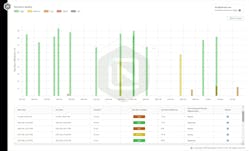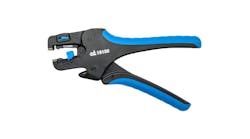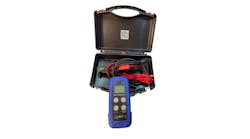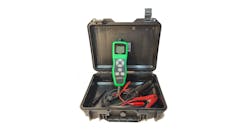When you have a superpower and don’t use it, the consequences can be dire. After getting his powers, Spider-Man let a robber slip by uncontested and his poor Uncle Ben paid the price. The wallcrawler famously learned the hard way that “with great power comes great responsibility.” Fleets now also have access to a great power, one that foresees their assets’ impending doom: predictive maintenance (PdX). And they have a responsibility to use this newfound “spidey sense” wisely to fight the pervasive menace of unplanned downtime.
This cutting-edge approach to vehicle maintenance ingests telematics and vehicle data , and then employs advanced analytics and machine learning to look for anomalies. If one or more are detected, the system can alert the fleet to intervene. Ideally, the maintenance team has enough time to swing in to make a fix, preventing a costly vehicle breakdown that tarnishes your relationship with both your driver and customer.
The question, though, is if and how you can responsibly implement this precognitive power into your operations. You don’t want to be so focused on preventing future problems that might happen that you lose sight of the problems right in front of you. This requires a bit of pre-planning to ensure this new tool adds value, not disruptions. The following guide should help you weave a good action plan, transforming you into a bona fide maintenance superhero.
Step 1: Figure out benefits
Predictive maintenance provides foresight far beyond the limitation of present vehicle diagnostics. Unlike waiting for a DTC to flag an issue, this prognostic method utilizes real-time and historical vehicle data with algorithms to identify and accurately predict a component failure. How accurate? One developer, Intangles, reported its predictions have a 95% success rate.
Exactly how does predictive maintenance manage to do all of this? The process begins with the continuous collection of data from a vehicle through sensors and other monitoring devices. Machine learning and statistical models then identify patterns and anomalies in the data indicative of potential issues or future failures. Through real-time condition monitoring, deviations from normal operating parameters trigger an immediate alert, enabling early intervention.
The perks of predictive maintenance extend past simply mitigating vehicle breakdowns and the subsequent financial burden of a sidelined truck, according to Vedant Khattar, CTO at Pitstop.
“The primary advantages our customers are seeing revolve around reducing vehicle downtime and lowering vehicle maintenance costs,” he said. Other benefits include fewer repeat shop visits and less troubleshooting/diagnostic time.
Read more: Impact of predictive analytics on DPF maintenance
Another big advantage is consolidating several streams of data in one place, saving users additional time.
“We’ve eliminated the need, for instance, to go to another website to check the troubleshooting guide,” Khattar said.
Pitstop’s primary focus is on integrating data from various sources, particularly in handling the overwhelming influx of fault codes encountered daily by most fleets. The platform includes a diagnostic module that provides extensive information, including historical data and troubleshooting guides.
“We’ve enhanced desktop functionalities to include additional metadata and explanations, ensuring users have all necessary information at their fingertips,” Khattar explained. “So they see their trouble code, the priority level, and all the historical timeline in one table.”
DVIR integrations can also give fleet managers easy access to vehicle history, reported issues, and even remote viewing of real-time sensor data.
In one example, Khattar said that by using this consolidated approach to vehicle data, Pitstop was able to identify a problem with a truck one full day before the driver even noticed an issue. By the time the driver logged the problem, the sensor data had already been noted on that vehicle’s health report and was forwarded to the maintenance team.
Vehicle alerts can be delivered in real-time or as a daily summary and categorized according to severity level. For time-pressed fleet managers keen on streamlining operations, a work order can be generated automatically, factoring in alert severity and vehicle availability. This level of automation ensures diagnostic data is available to technicians even before the vehicle reaches the shop, allowing for proactive measures like advanced parts ordering.
When it comes to the transportation industry, success stories with tangible and impactful results are the ultimate litmus test. PdX provider Uptake shared a compelling narrative of real-world outcomes for one of their client’s fleets in the context of engine-related breakdowns. The implementation reduced engine-related breakdowns by 30-50% year-over-year, Uptake said. The consequential effects extend beyond statistical improvements, manifesting in a noticeable decrease in days spent in the shop and a streamlined turnaround time for releasing trucks.
In another example, Intangles helped conserve a waste management fleet’s bottom line. Previously, the fleet kept a reserve fleet of five waste trucks because of frequent breakdowns; however, after adopting the AI-enabled software, the refuse fleet saw a substantial increase in uptime, explained Alan McMillan, president of Intangles. This allowed them to sell off three out of their five reserve vehicles.
“What’s the ROI on that?” McMillan asked. “Those trucks were running more efficiently with fewer breakdowns. Customer satisfaction goes up, and their asset availability increases.”
Step 2: Overcome hesitancy
Despite its potential, predictive maintenance, still firmly planted in its ‘early-adopter’ phase, hasn’t attracted as much customer interest as expected.
Uptake President James Rice acknowledged that fleets have displayed a measured and cautionary pace when adding PdX to existing workflows. “There’s consistent growth in this area year-over-year, though not at the desired rate,” Rice explained. “Predictive maintenance lacks a deep history and widespread prior experience, and people often struggle to grasp the nuances as it’s more than just collecting fault data.”
Dave Walters, a senior software engineer at Trimble with more than 40 years of industry experience, attributed the lethargic growth to “a lot of confusion between preventive maintenance and predictive maintenance—and what we can and can’t do today with software.”
Intangles’ McMillan agreed that some in the industry incorrectly conflate the two and suggested this was due to inconsistent marketing language.
“A lot of OEMs are confusing the market by calling Diagnostic Trouble Codes predictive, and they’re not,” he said. “DTCs only emerge once the ECU has recorded an issue that’s already occurred. By that time, that unit has been traveling down the highway losing money and causing more issues to happen.”
Because terms aren’t clearly defined, fleets that integrate predictive maintenance can run into problems when dealing with an outside maintenance provider that does not have access to predictive data.
“That shop does a normal diagnostic on it and doesn’t see a trouble code, so that could be a challenge,” McMillan said. “That shop doesn’t see anything because their diagnostic equipment is not telling them.”
Read more: Data-powered predictive maintenance with Uptake
Confusion exists, in part, because both preventive and predictive maintenance involve analyzing sensor data for irregularities, such as fluctuating oil temperature, to identify and provide insights on potential issues. A temperature irregularity may not be enough to trigger a DTC, though it could be enough to signal to the PdX system that something isn’t right. This is because the AI compares the new data against historical oil temperatures, putting into context if current operations are normal or abnormal.
PdX also has the ability to detect patterns and learn, enabling algorithms to spot issues faster and more accurately over time. That’s the conceit, anyway. For small fleets (that are typically late adopters) to truly overcome hesitancy, it will take time. As PdX ingests more data and becomes wiser with how to help fleets operate more efficiently, tales of its power will likely spread, and higher take rates will follow.
Step 3: Implement data
Once an operation decides PdX can and should be adopted, management should embrace it wholeheartedly, Rice advised.
“Don’t be resistant to change,” he said. “Consider the shift from manual to automatic transmissions or paper logs to ELDs—initially challenging, but now indispensable. Do you want to continue to receive thousands of fault codes a day, or would you rather have a more streamlined and organized approach?”
In this respect, fleets must remember that with any computing system, even AI, “garbage in/garbage out” still applies. You want a large sample size of data to empower your PdX, but it has to be the right data.
Utilizing Vehicle Maintenance Reporting Standards (VMRS) codes, created by the Technology & Maintenance Council in 1970, could be just what PdX needs.
“It’s been the ‘universal’ maintenance language for more than 50 years and continues to prove to be flexible and adaptable,” reasoned Jack Poster, TMC’s VMRS guru, who added “there needs to be an agreed-upon method of interpreting and implementing the received [DTC] data, and many believe VMRS is the perfect method.”
A new initiative, spearheaded by Brian Mulshine, now a senior director of product management at Trimble, aims to use VMRS to standardize common language and maintenance alerts and communication between the back office and vehicle to better coordinate service. A new code key would need to be created and would help separate future service events into past due, due soon, and needs replacement soon.
“The codes can be used across all vehicle/engine OEMs and component suppliers to digitally communicate predictive and prognostic maintenance and repair requirements,” Poster said.
Step 4: Train technicians
Andrew Bartholomew, assistant product marketing manager from CMMS provider Fleetio, explained that training technicians to effectively leverage PdX can further empower the technology.
“Basic training might consist of comprehensive programs exploring how to use the technology to interpret vehicle data and troubleshoot,” he said. “New technicians should have a structured onboarding process that includes dedicated training on predictive maintenance.”
Bartholomew added that mentorship from more experienced techs, continued professional development, and documentation “knowledge hubs” will help acclimate all techs in the bay to using this powerful tool every day.
Such training is not only foundational but also extends to structured onboarding, fostering a culture of continuous learning.
McMillan echoed the importance of such initiatives by addressing the pressing issue of hiring less-experienced technicians. He said that many fleet customers have asked for Intangle’s help in this area.
“Experienced technicians are increasingly scarce due to the growing complexity of vehicles and limited hands-on experience for new students. Consequently, technicians rely heavily on technology for problem diagnosis,” McMillan explained.
“Intangles assists technicians by preemptively flagging potential issues and offering predictive alerts, detailed symptom and cause lists, severity assessments, and recommended repair paths. This empowers less-experienced technicians to efficiently address problems using our intuitive platform,” he said.
Read more: Intangles offers AI-powered DPF monitoring
By providing real-time insights and predictive analytics on each vehicle’s performance, it ensures technicians have access to comprehensive diagnostic data and a clear repair path to swiftly resolve issues, regardless of their skill level.
To prevent unnecessary downtime, technicians must be able to rely on accurate diagnostic data. Intangles addresses this by achieving 95% accuracy when forecasting component-level failures in real-world scenarios. This degree of accuracy is attained by blending physics-based models and AI prognostic methods, leveraging machine learning and data analysis to identify patterns and trends.
Physics-based models meticulously analyze vehicle component behavior, offering precise insights into degradation and potential failure modes. However, they require in-depth knowledge of system behavior.
To complement this, Intangles utilizes AI techniques to extract structured information from vast datasets collected from over 150,000 vehicles. With approximately six billion sensor parameters processed daily, layered machine learning algorithms continually update the physics-based model with real-time data. This hybrid approach ensures accurate predictions under various environmental and stress conditions, similar to real-world operating environments.
Step 5: Evaluate preparedness
Fleets contemplating the integration of predictive maintenance into their telematics face the critical task of assessing their readiness. Establishing KPIs will enable this, Bartholomew noted.
“An ideal indicator would be when an increasing proportion of downtime or repair spend is resulting from repairs that couldn’t be avoided with a comprehensive preventive maintenance system,” he said. “If a fleet’s preventive maintenance process is in order, it’s easier to think ahead; there aren’t going to be as many unexpected issues popping up and taking all of the focus.”
One of Fleetio’s customers operating in the construction space estimated that his mechanics historically spent around 30% of their time doing PMs and the rest reacting to vehicle issues as they surfaced. After implementing Fleetio, the proportion of time spent on PMs roughly doubled, showcasing a proactive shift in their approach. This brought annual repair spending down by 30% and showcased a prime instance of fleet readiness for integrating predictive maintenance.
McMillan said that for fleets operating older and/or high-mileage trucks, the need for predictive maintenance becomes more pronounced.
“Typically, if you’re running a little bit older fleet like two to four years, it’s got enough miles to start having issues around the powertrain, and you want to be able to be notified before that engine blows,” McMillan explained. “If somebody has 100% all brand-new trucks and they’re all under warranty, they may be less interested in having an AI prediction because the odds of having an issue are far less.”
McMillan noted some fleets may still want predictive technology to ensure the asset is working properly.
In evaluating your fleet’s preparedness, engaging with your telematics provider is a recommended first step as they offer dynamic and scalable predictive maintenance solutions that can adapt to evolving business requirements.
Hieu Bui, VP of product at Platform Science, a leading telematics technology provider, emphasized that because every fleet is different, customization and collaboration are crucial.
“We always work with our partners to tailor an implementation plan,” he said. “All of our partners in our marketplace are really hands-on with developing a plan, so we partner with them to learn about the fleet, what their goals are, and what matters to them.”
This can include the acquisition of new vehicles, changes in regulatory compliance, electrification, and even autonomous vehicles, Bui noted.
Step 6: Mitigate data overload
For fleet managers, the specter of data overload casts a formidable shadow. As vehicles evolve into smarter and more connected entities, the constant influx of data raises a pertinent question: How genuine is the risk of predictive data overload?
Read more: Using AI to combat data overload
Any abundance of information holds the potential to overwhelm, making it difficult to extract meaningful insights. The surge of data being generated has become a double-edged sword, often leading to breakdowns rather than preventing them.
“The amount of data coming off the truck and the number of sensors in the trucks is growing exponentially,” Bui said. “So what we’re seeing is if you don’t treat that data right and do the right things with it, it becomes a negative. If I’m flooded with all of this data and I can’t make sense of it, I’m going to make the wrong decisions.”
The phenomenon of “data numbness” finds support in psychological circles, aligning with the well-known concept in psychology called “decision fatigue.” This term signifies a noticeable decline in decision-making quality after prolonged exposure to a substantial volume of information.
Rice elaborated on the concept of data overload, highlighting its potential to induce another psychological phenomenon termed ‘inattentional blindness.’ This phenomenon occurs when individuals focus on a specific aspect they are familiar with, consequently overlooking other significant details.
Rice explains that “with an increasing number of codes being generated by trucks, there’s a tendency to overlook the sheer volume of data. Instead, attention is often directed only to a select few high-value or high-impact codes. This reactive approach persists, leading to a cycle of diagnosing problems after they’ve occurred.”
Companies at the forefront of predictive maintenance are actively contributing to alleviating data overload. They achieve this by employing advanced AI algorithms to sort and prioritize fault codes, consolidating them based on specific criteria such as timeframe, frequency, and density. Applied against historical operating parameters, this strategic approach allows for an intelligent assessment of cumulative impact and helps determine whether attention is warranted before sending out an alert.
By embracing the entirety of a truck’s diagnostic data, PdX companies believe they have plotted a clear path between information abundance and strategic discernment and will take the guesswork out of decision-making.
The ultimate goal of PdX is to aid fleet managers in the planning and allocation of resources based on the AI’s recommendations. And the power of predicting maintenance issues well in advance will likely enhance the entire fleet’s performance, allowing for better technician scheduling, parts ordering, and overall utilization.
Fleets should keep in mind that even superheroes with a spider-sense for danger sometimes fail, and mastery of any power takes hard work and contemplation. Building and sticking to a plan, and training maintenance teams to execute it, will determine if you are able to only predict a negative future—or prevent it altogether.






